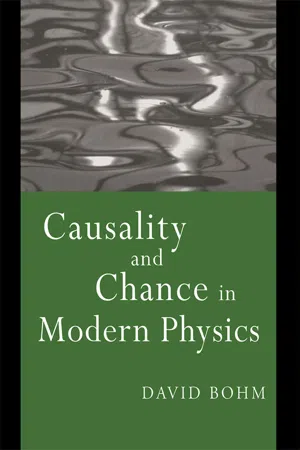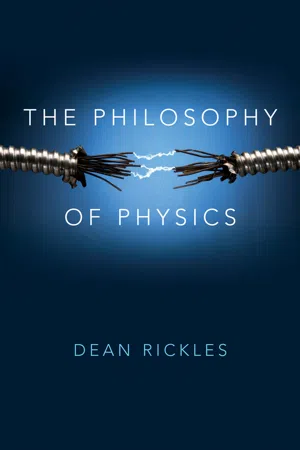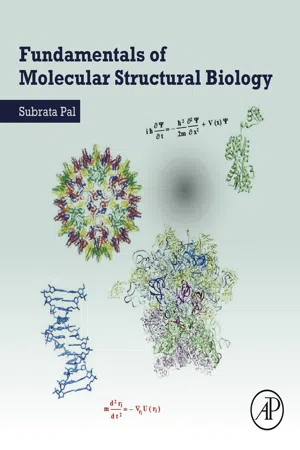Physics
Classical Mechanics
Classical mechanics is a branch of physics that deals with the motion of objects and the forces acting on them. It encompasses the study of Newton's laws of motion, the conservation of energy and momentum, and the behavior of particles and rigid bodies. Classical mechanics provides a framework for understanding and predicting the behavior of macroscopic objects at everyday speeds and scales.
Written by Perlego with AI-assistance
6 Key excerpts on "Classical Mechanics"
Learn about this page
Index pages curate the most relevant extracts from our library of academic textbooks. They’ve been created using an in-house natural language model (NLM), each adding context and meaning to key research topics.
- eBook - ePub
- David Bohm(Author)
- 2004(Publication Date)
- Routledge(Publisher)
2. Classical Mechanics
The most important developments in physics between the sixteenth and the nineteenth centuries were founded on a certain body of very general, very comprehensive, and very precisely expressed theory usually referred to as Classical Mechanics , which concerns itself primarily with the laws governing the motions of bodies through space. Now in the earlier stages of their development (as in the times of the ancient Greeks), the laws of mechanics had generally been given a vague and qualitative form.* With the work of Galileo and others, however, the tendency to express the laws of physics (and to some extent of chemistry and other sciences) in a precise quantitative form began to assume a very great importance. This trend towards quantitative precision in the expression of physical law continued to grow, and first reached its full development with Newton’s laws of motion. These laws, which state that the acceleration of a body is directly proportional to the force acting on it and inversely proportional to its mass, are expressed mathematically by means of the differential equation, where x→ is the position vector of the body, F→ the force acting on it, and m is its mass.Newton’s laws of motion imply that the future behaviour of a system of bodies is determined completely and precisely for all time in terms of the initial positions and velocities of all the bodies at a given instant of time, and of the forces acting on the bodies. These forces may be external forces , which arise outside the system under investigation, or they may be internal forces of interaction between the various bodies that make up the system in question.In many problems the external forces are small enough to be neglected (i.e. the system may be regarded as isolated), while the internal forces can be represented solely in terms of functions of the positions and velocities of the centres of mass of the bodies. This approximation is particularly good in the problem of the motion of the planets around the sun. In such a case, Newton’s laws determine the future motions of the bodies in terms of nothing more than the positions and velocities of the bodies at a given instant of time. Thus, they constitute a set of “one-to-one” causal relationships, of the type described in Chapter I , Section 7 - eBook - ePub
- Hani M. Tawancy, Anwar Ul-Hamid, Nureddin M. Abbas(Authors)
- 2004(Publication Date)
- CRC Press(Publisher)
3Principles of Mechanics
3.1 Introduction
Mechanics is a branch of physical science dealing with the macroscopic behavior of matter under the influence of a mechanical force. By macroscopic is meant that matter is viewed on a continuum basis with no regard to its constituent atoms or molecules. Generally, mechanics is divided into two main fields: (i) statics and (ii) dynamics. As its name implies, statics is concerned with the cases where no motion is produced by the applied force. Conversely, dynamics deals with motion under the influence of force.In studying the behavior of a body under the influence of an applied force, two main cases are distinguished: (i) rigid bodies and (ii) extensible or deform- able bodies. A rigid body is assumed to be nondeformable under the influence of applied force; i.e., the distance between two points prescribed within the body remains unchanged after applying the force. Important principles of mechanics are developed on the basis of rigid bodies. In practice, however, a body undergoes a change in shape or dimensions, or shortly is deformed in response to the applied force. To study the various mechanical properties of materials, the principles developed to treat rigid bodies in this chapter are extended to cover the mechanics of deformable bodies in Chap. 5 .Other specialized fields of mechanics particularly stress analysis and fracture mechanics are of extreme importance to engineering design and failure analysis. It is the primary objective of stress analysis (Chap. 5 ) to evaluate the stresses developed in an engineering product by applying the principles of mechanics. Knowledge of these stresses allows the designer to select proper materials permitting safe operation of the product. Depending on the particular case of failure, it may be required to evaluate the stresses developed in the part during service and their path to determine the sequence of events leading to the failure. Fracture mechanics (Chap. 6 - eBook - ePub
An Illustrated History of Science
From Agriculture to Artificial Intelligence
- Mary Cruse(Author)
- 2019(Publication Date)
- Arcturus(Publisher)
But the story really got going in late 16th-century Italy. Here, polymath Galileo Galilei set the foundations for Classical Mechanics – the physics of the motion of bodies – with his famous thought experiment. Galileo argued that if one discounts the air resistance that causes a feather to float serenely to the ground, all bodies fall at the same rate, whether they’re heavy or light. This idea was important because it suggested that something other than weight is responsible for drawing objects towards the Earth.In the 17th century, the British polymath Isaac Newton proposed an answer. In 1687, Newton published his three laws of motion and his law of gravity. Together, these theories explain why objects behave in the way that they do when in motion, when still and when force is applied to them. Newton proposed that gravity is a universal force which works to pull all objects in the universe closer together. Gravity, he argued, is responsible for something as small as drawing a falling apple to the ground, and as large as keeping the planets in orbit. Newton’s work was groundbreaking, but there were gaps in the theory that scientists would return to in the 20th century.Newton’s laws of motion explain why objects behave in the way that they do when in motion, when still, and when force is applied to them.Did You Know?
The concept of atoms has a long history. The Ancient Greeks were the first to come close to an accurate theory of matter, when in the 5th century BC , a Pre-Socratic philosopher named Democritus (see page 133 ) suggested that all matter is made up of infinite, indivisible particles called ‘atoms’.THERMODYNAMICS
An important branch of physics known as thermodynamics had its start in the 18th century. Concerned with the relationship between heat and other forms of energy such as mechanical work (the amount of energy transferred by a force), thermodynamics came about largely because many physicists were interested in the science behind what causes objects to warm up and cool down. - eBook - ePub
- Dean Rickles(Author)
- 2016(Publication Date)
- Polity(Publisher)
kinesis as a kind of ‘potential’ state of being while dynamics was an ‘actual’ state of being. Historians have wracked their brains over this distinction of Aristotle’s for many centuries, but translated into our terms we can see that kinematics concerns possible motions when we ignore the action of any forces and laws of nature in the spatiotemporal background, while dynamics concerns what motions can be actual once the laws (such as Newton’s laws of motion) are introduced. Mechanics is classically understood to be a fairly straightforward combination of these two components: kinematics + dynamics. All features of a world are understood to flow from a specification of both elements.The kinematically possible trajectories will of course include the dynamically possible trajectories: the former space of possibilities is far larger than the latter. The modern distinction can be linked fairly closely to Aristotle’s (from the previous chapter) by focusing on what is possible in the two scenarios: kinematics is about which motions are possible given the constraints of the spacetime itself along with the barest features of the basic objects (so that, for example, in a world with three dimensions, motions requiring more dimensions will not be kinematically possible). We can think of these as metaphysically possible worlds, but not necessarily physically possible worlds: worlds that are conceivable, but are perhaps not compatible with our laws. Physical reasonableness is the province of dynamics, which narrows down the space of metaphysically possible worlds to a family of physically possible worlds: worlds that are compatible with our laws. We can think of the introduction of dynamics as a demand for explanation concerning why things change their motions (or stop): this demands forces (and we have the law of inertia, embodying the tendency of bodies to stay in motion unless forced to do otherwise). Hence, we have the standard conception of kinematics as the study of the motions of bodies in the absence of forces, and dynamics as the study of the effects of forces on those motions.Though we utilize mathematics in this representation of trajectories (motions), especially using geometrical notions, there is a radical disconnect in how the physically applied concepts relate to the pure (mathematical) concepts. For example, a motion in the geometrical sense simply involves associating one point to another point, with no sense of a continuous trajectory linking them (at least not of necessity: one could imagine the point being carried along in a continuous path, but it is not essential). In the case of physical motions, however, the smooth paths between initial and final points are crucial, and form part of our picture of how the world works – not least because we often need to know the duration of the time interval during which some continuous path was traversed. But deeper than this (though not undeniable) is the belief that in order to get from a point A to a point B, the points in between must be traversed, during which the object that moves retains its identity in some sense (and so is the same object at B as it was at A - eBook - ePub
- Subrata Pal(Author)
- 2019(Publication Date)
- Academic Press(Publisher)
Chapter 3Physical basis of chemistry
Abstract
Physics has been the chief agent in transforming molecular biology into molecular structural biology. This chapter gives an overview of different areas of physics as a minimum requirement for the experimental and theoretical understanding of biomolecular interactions and dynamics. The layout of the topics is somewhat similar to one that would appear in an exclusive textbook on basic physics—Classical Mechanics, wave motion, kinetic theory and thermodynamics, and quantum and statistical physics; nevertheless, the presentation here is purely introductory. In each of the topics, mathematical expressions and equations have been judiciously used to deliver some quantitative sense. All such is expected to facilitate meaningful deliberations in the subsequent chapters.Keywords
Classical Mechanics; Wave motion; Kinetic theory and thermodynamics; Quantum physics; StatisticsRichard Feynman, Nobel Laureate in Physics in 1965, had said, “there is nothing that living things do that cannot be understood from the point of view that they are made of atoms acting according to the laws of physics.” On the one hand, physics has provided very powerful techniques such as X-ray crystallography, a wide variety of spectroscopy, and electron microscopy to investigate the biological system at the atomic level. At the same time, physics has also placed chemistry on a sound theoretical foundation from where it has been able to characterize complex molecules and unravel intricate molecular mechanisms of life.3.1 Classical Mechanics
3.1.1 Matter and motion
Let us begin by considering an object in motion. The simplest object would be a dimensionless particle. At any particular time t , the location of the particle can be denoted by the position vector r :r = xi ˆ+ yj ˆ+ zk ˆ(3.1)wherei ˆ,j ˆ, andk ˆ - Kenneth Clatterbaugh(Author)
- 2014(Publication Date)
- Routledge(Publisher)
Newton often prefers the term “rational mechanics” as contrasted with the “geometrical mechanics” of his predecessors, notably, Gassendi, Hobbes, Descartes, and Rohault. And it is rational mechanics that is presented in the Principia. Rational mechanics will be the science of motions resulting from any forces whatsoever accurately proposed and demonstrated. (TH, 10) The forces that Newton mentions by name are those of gravity, levity, elastic force, and the resistance of fluids—these are forces “attractive or impulsive” (TH, 10). The model of science which Newton proposes is to investigate “from the phenomena of motions … the forces of nature, and then from these forces to demonstrate the other phenomena” (TH, 10). The last step is crucial because it provides the justification for the postulation of forces unknown and not manifest. Newton draws on the success of his own physics; speaking of the Principia, he writes: I wish we could derive the rest of the phenomena of Nature by the same kind of reasoning from mechanical principles, for I am induced by many reasons to suspect that they may all depend upon certain forces by which the particles of bodies, by some causes hitherto unknown, are either mutually impelled toward one another and cohere in regular figures, or are repelled and recede from one another. These forces being unknown philosophers have hitherto attempted the search of Nature in vain; but I hope the principle here laid down will afford some light either to this or some truer method of philosophy





